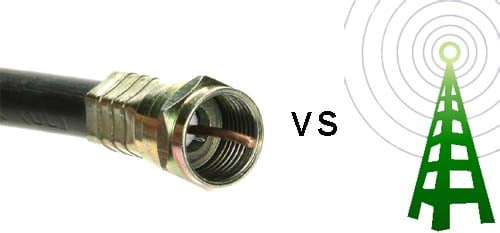Cable Growing Faster Than Wireless
Although many would guess otherwise, the cable industry is actually growing faster than the wireless sector. This surprising fact comes courtesy of Bernstein Research analyst Craig Moffett. He explains in his latest Weekend Media Blast piece that while subscriber growth in the wireless industry over the last 12 months is up 5.3%, revenue per subscriber is down 1.7%. In terms of revenue growth, the wireless industry is at just 3.6%. By comparison, the cable industry grew revenue per subscriber 4.1% over the same time period. When combined with modest subscriber growth, the cable industry enjoyed an industry growth of 5.3%.
According to Moffett, there are a number of reasons why cable wins, including the fact that the wireless industry is much more competitive than the cable industry. For example, in the wireless industry, there are five facilities-based carriers in most markets (AT&T, Verizon Wireless, Sprint, T-Mobile, and either Leap Wireless or Metro PCS). Some markets also have regional players such as U.S. Cellular. In addition, the wireless industry is still seeing new entrants to the market. Cox, for example, is building out a system that will compete in 10% of the country. To top it all off, there are resellers such as Virgin Mobile and Tracfone as well as competitors such as Clearwire who is in the process of building out a national WiMAX service.

The pay TV market has far fewer competitors: In 75% of the country, there are just three players (the cable company, DirecTV, and Dish Network). In the rest of the country, there are four players, with the addition of Verizon’s FiOS service or AT&T U-Verse.
The cable companies have yet another benefit: broadband. In most markets, there are only two competitors—DSL from the phone company and cable. Thanks to high demand from consumers and little competition, cable companies have been able to increase the price of broadband over the last five years.
“Like it or not, cable wins this game,” Moffett writes. “They got there first with a truly high capacity pipe into the home, and in the majority of America they will remain almost unchallenged.”
Wireless operators aren’t taking Moffett’s comments lightly. Bill Kula, Verizon spokesman, wrote to explain why he believes his company has a benefit that Moffett hasn’t considered: “Moffett’s notion that cable has a “high capacity pipe into the home” is pure bunk. Big Cable’s hybrid fiber/coax connection lands light-years (pun intended) behind Verizon’s 100% straight-to-the-home fiber optic network that delivers FiOS service with speeds up to 50 mbps downstream and up to 20 mbps upstream. The consistency of the connection, and ability to deliver considerably higher quality video signals is a proven winner, and has the cable companies on the run, and using errant claims.”
According to Moffett, there are a number of reasons why cable wins, including the fact that the wireless industry is much more competitive than the cable industry. For example, in the wireless industry, there are five facilities-based carriers in most markets (AT&T, Verizon Wireless, Sprint, T-Mobile, and either Leap Wireless or Metro PCS). Some markets also have regional players such as U.S. Cellular. In addition, the wireless industry is still seeing new entrants to the market. Cox, for example, is building out a system that will compete in 10% of the country. To top it all off, there are resellers such as Virgin Mobile and Tracfone as well as competitors such as Clearwire who is in the process of building out a national WiMAX service.

The pay TV market has far fewer competitors: In 75% of the country, there are just three players (the cable company, DirecTV, and Dish Network). In the rest of the country, there are four players, with the addition of Verizon’s FiOS service or AT&T U-Verse.
The cable companies have yet another benefit: broadband. In most markets, there are only two competitors—DSL from the phone company and cable. Thanks to high demand from consumers and little competition, cable companies have been able to increase the price of broadband over the last five years.
“Like it or not, cable wins this game,” Moffett writes. “They got there first with a truly high capacity pipe into the home, and in the majority of America they will remain almost unchallenged.”
Wireless operators aren’t taking Moffett’s comments lightly. Bill Kula, Verizon spokesman, wrote to explain why he believes his company has a benefit that Moffett hasn’t considered: “Moffett’s notion that cable has a “high capacity pipe into the home” is pure bunk. Big Cable’s hybrid fiber/coax connection lands light-years (pun intended) behind Verizon’s 100% straight-to-the-home fiber optic network that delivers FiOS service with speeds up to 50 mbps downstream and up to 20 mbps upstream. The consistency of the connection, and ability to deliver considerably higher quality video signals is a proven winner, and has the cable companies on the run, and using errant claims.”

